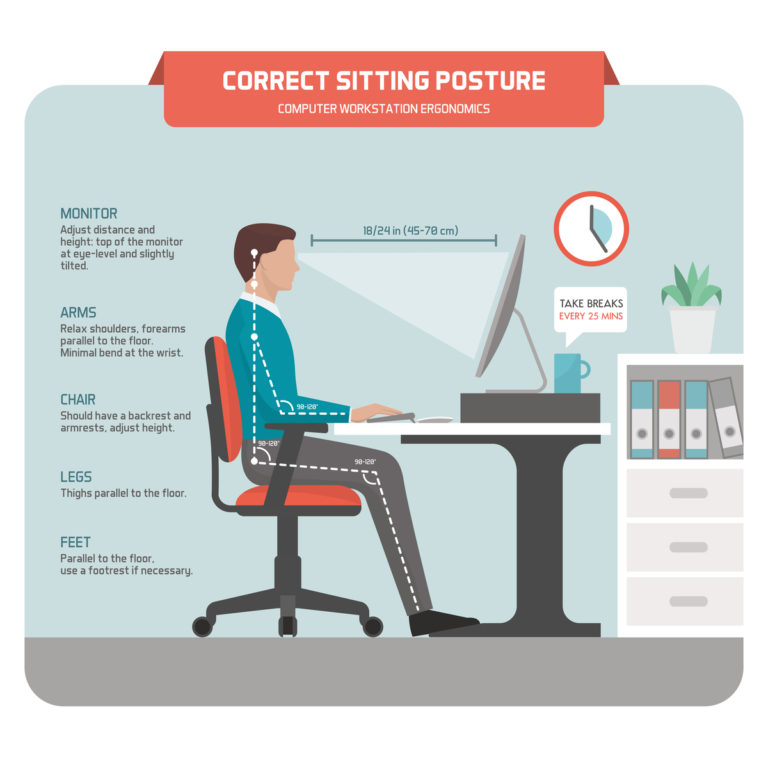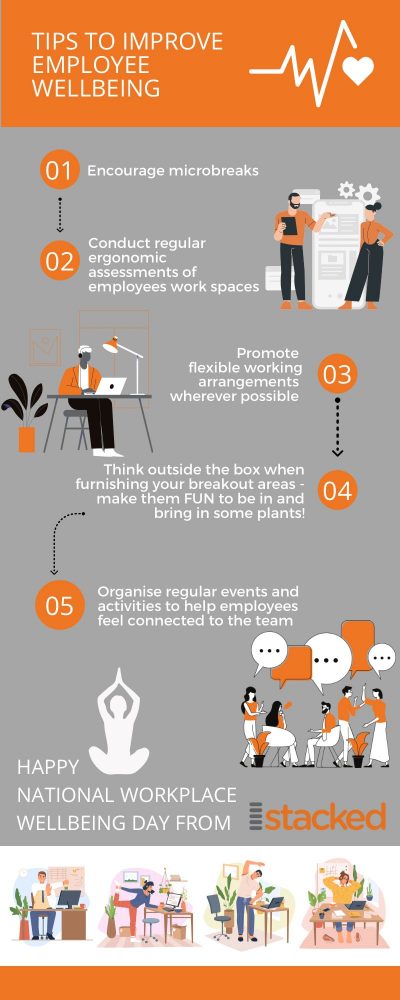Happy National Workplace Wellbeing Day
by Niamh Cardiff
Ergonomics – a marketing buzzword? or sense behind the science?
A word you’ve probably heard before but what does it mean? Or more importantly what does it mean for your workplace?
Personally, coming from a hospitality background, where you’re on your feet all day and grabbing food on the go, to a desk based office environment, this topic has never been so relevant for me.
So why is ergonomics important? The setup of our desks, the adjustability of our chairs, the position of our laptops may seem like minor concerns but they all become really important when we are sitting in one place for a long period of time. The more optimised your ergonomics are, the more comfortable your working space will be, therefore helping you to work more productively. Makes sense doesn’t it?

What is ergonomics?
You might be surprised to learn that ergonomics is actually considered a science. It is an applied science concerned with designing and arranging objects that people use so that the people and objects interact as efficiently and safely as possible.
Essentially everything we use is ergonomic in that it will affect our health and wellbeing in some way. When you are doing a job and your body is stressed by an awkward posture, extreme temperature, or repeated movement your musculoskeletal system is affected. Short term this is not good for our wellbeing, long term it can cause actual health problems such as repetitive strain injury, circulatory issues and back and neck strain.
Being surrounded by good quality ergonomic products means we can be more efficient and comfortable not only in our daily lives but also in the workplace. A good example is driving. If you get into a car after another person has been driving it, the first thing you do, without even thinking about it, is adjust the seat and the mirrors so that you can reach the pedals comfortably and see hazards clearly.
Ergonomics is also sometimes referred to as ‘human factors engineering’. It’s all about how you can make an environment more suitable for the human body. Products that are developed with ergonomics as a consideration allow users to focus strength and energy on the tasks at hand while avoiding harmful effects. The idea is to fit the task to the worker – not the worker to the task.
How can ergonomics benefit the workplace?
Ergonomics in the workplace is concerned with the ‘fit’ between people and their work. Five key aspects of this are safety, comfort, ease of use, productivity, and aesthetics. Achieving an optimal ergonomic environment can help office employees avoid injuries and discomfort and in turn will help improve productivity. A healthier workforce obviously means less sick days and more engaged employees which benefits both the employee and the company.
Did you know?
- 95% of an office workers’ day is spent in front of a computer
- Musculoskeletal injuries from poor workplace ergonomics account for 34% of all lost workday injuries and illnesses
- Carpal tunnel syndrome accounts for 15% of all workplace injuries
Having correct ergonomics in your work environment can help avoid injuries and can increase productivity by up to 11%.

One key feature of ergonomics that stands out no matter what the product is, is ‘adjustability’. For example, if you are purchasing a new office chair you want to ensure it is supportive and comfortable but also highly adjustable. Proper lumbar support is key to keeping your neck and spine properly aligned throughout the day. You should be able to move the back of the chair and arms to find the most comfortable position for you, as well as the height of the chair and ideally the depth of the seat pan too.
Often the issue is actually the height of the desk, not the adjustability of the seating. Many standard office desks, especially pods and modular desking in open plan offices are set a a specific height and are not adjustable, which means if you are a little shorter or taller than the ‘average’ person, you will be forced to higher or lower your seat to match the desk – which then means you are not able to sit in a position that aligns your spine correctly. Using accessories such as foot rests, monitor risers and back supports can can help you to improve ergonomics without replacing furniture, if cost is an issue.
After investigating some of the adjustable furniture products available on the market, I can see that there is absolutely sense behind the science. I am sure anyone who works long days at a desk/computer will agree, comfort is key and even something as small as a wrist rest can make a huge difference. There are plenty of affordable options and even small adjustments to seating and desks can lead to improvements in comfort and productivity. Done right, a focus on ergonomics will absolutely result in increased worker well being and optimised performance.
National Wellbeing Day, 29th April 2022
Never has embedding a sustainable, long-term approach to health and wellbeing been so important as the world of work continues to evolve following the disruptions and changes that last few years have brought.
April 29th offers an anchor to rebalance and refocus on supports that will benefit employees’ social, mental and physical wellbeing. According to IBEC organisations who embed a culture of wellbeing and that support the mental and physical wellness of their workforce, are the same ones who are more effective at ensuring the attraction and retention of employees, so it’s something worth considering, both for employees and employers.
Happy National Wellbeing Day from Stacked.
Take this day to show your commitment to the wellbeing of your staff – and of course have fun!
#workwell22







